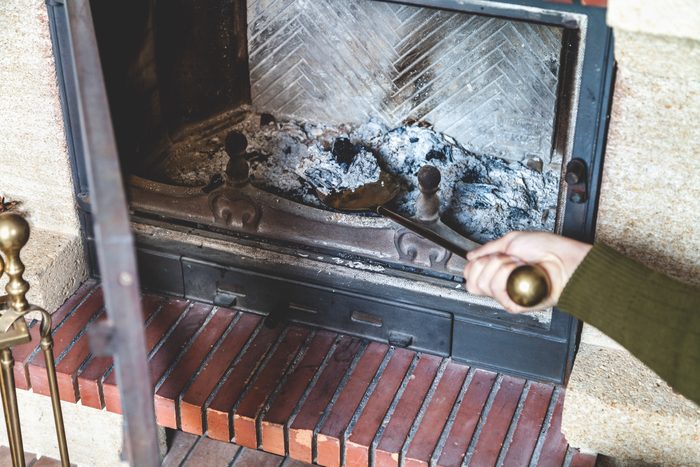15 Ways To Use Fireplace Ash
Updated: Aug. 02, 2023

You don't need to throw out your fireplace wood ash. Try these savvy ways to use it.
Uses for fireplace ash? What’s left to use?
The only thing I could think of involves lutefisk, a fish Scandinavians love if prepared properly, or hate if it’s not. Lutefisk is dried lingcod reconstituted with a lye solution, traditionally wood ashes mixed in water.
Turns out there are a lot more uses for fireplace ash. Sharon Wilczek owner of Paul’s Fireplace Wood, Inc., in Little Falls, Minnesota, shared the following ingenious suggestions. I plan to try at least 10!
In the Garden
“I use a lot of ashes in my garden,” says Wilczek. “Ashes have nutrients like potassium, magnesium and calcium and are good for blueberries and azaleas, for example.
“Sprinkle ash from your fireplace in your gardens in fall and winter, and then in spring you work the ash into the soil. It doesn’t cost you anything because you’re just using ash from your fireplace instead of throwing it away.”
NOTE: Do not use ashes from manufactured logs or charcoal. They often contain petroleum waxes or other potentially harmful ingredients.
In Compost Piles
Ashes layered into your compost increases the potassium in your mulch.
Around Young Tomato Plants
“If you put a ring of fireplace ash around young tomato plants, it keeps cutworms away,” says Wilczek. “The cutworms won’t go through the ash. I learned this from my grandmother, and she planted 75 tomato plants every year!”
Prevent Blossom End Rot
Blossom end rot occurs when the tissue of the end of the fruit opposite the stem breaks down. It’s a common garden problem caused by a calcium imbalance within the plant. It can occur in pepper, squash, cucumber, melon and tomato plants.
Spread around a small amount of ash and scratch it into the soil. Do not over apply because that can make the soil pH too high.
As a Bug Repellant
“Ash is good for keeping away snails and bugs like ants,” says Wilczek. “I use ash to keep slugs away from my hostas. These critters don’t like crossing the ash.”
Ashes are also a tick repellant. Spread ash on your bare skin before starting an outdoor hike. You’ll look dirty, but it’s better than picking up a tick that spreads Lyme disease or Rocky Mountain spotted fever. And it’s better than spending money on a smelly insect repellant.
For Cleaning
“I’ve used ashes for cleaning fireplace doors,” Wilczek says. “You make a paste by mixing ash with water. Use only the fine ash and rub the paste on the glass doors. It makes for a mild abrasive and will clean off the burned residue.
“You can use this paste on tarnished metal or on jars that have a sticky residue from a label. But make sure you wear gloves when you work with this paste.”
To Control Pond Algae
The potassium in wood ash can fortify rooted aquatic plants, making them compete with and slow algae growth in a pond.
To Absorb Odors
Wood ash absorbs moisture and odors from the air. Put a small bowl of it in your refrigerator or a musty room.
To Remove Driveway Oil Stains
Spread ash on the oil. Let it absorb the oil for several hours before sweeping away the ash-oil mix.
As an Ice Melt
The potassium in fireplace ash melts ice in mild winter temperatures. Also, the ashes provide traction on icy roads or walkways. “You just want to be careful not to track any of that ash from your shoes or boots into your house,” Wilczek says.
To Make Soap
“You can make homemade soap with ash,” Wilczek says. “This soap is really good for washing clothes and making them white.”
To Remove Skunk Stink
If your pet crosses paths with a skunk, rub odor-eating ashes into its fur to remove the stink.
As an Alternative to Bleach
Make lye water by mixing ashes and water. Lye water can be used as a natural bleach.
To Put Out Fires
Wood ashes can help put out a fire when a fire extinguisher, soil or sand is unavailable.
As a Natural Toilet Cleaner
Bleach-based toilet cleaners kill the natural bacteria that keep a rural septic system working properly. Wood ash cleans toilets as well as tile and other bathroom fixtures, and promotes waste breakdown in the septic tank. It also prevents smell in outhouses and camp toilets.
“My daughter asked that I help her get rid of her fireplace ash,” says Wilczek. “I said, ‘Just put it on your garden.’ She had no idea to do that, and that is the problem.
“People put ashes in their trash because they don’t know what else to do with them. You can use them and recycle them. It’s the natural way. People need to be educated on this, on using something they already have if they burn wood. And there’s no extra cost to it.”
